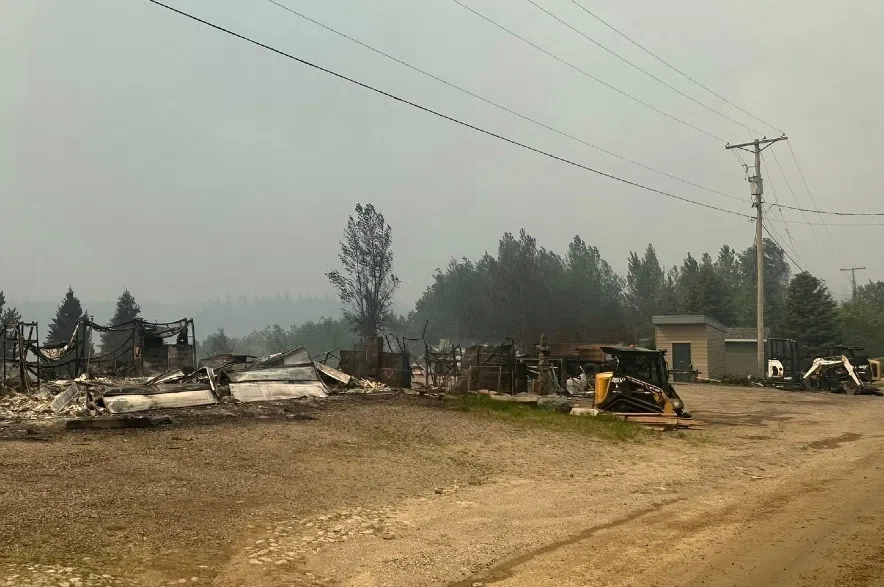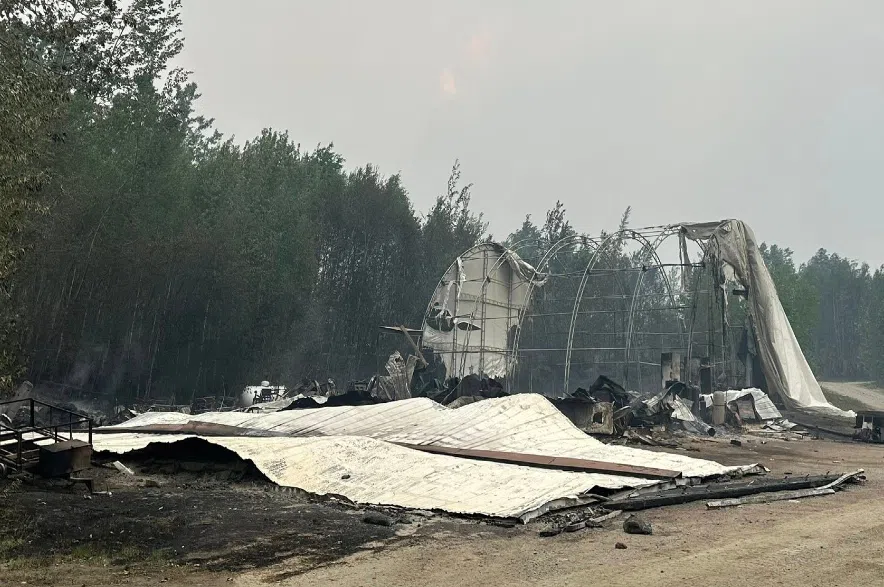On Tuesday night, all non-essential, non-emergency staff in a 20 km radius of the La Ronge area were told to evacuate because of “very dangerous” conditions that SPSA said were “quickly evolving.”
A video posted to Facebook showed flames burning close to the Rona at 312 La Ronge Ave in the town.The fast-moving Pisew Fire that forced the evacuation of approximately 7,500 people from Air Ronge, La Ronge and Lac La Ronge Indian Band communities on Monday.
Meanwhile, a water bomber pilot from La Ronge has lost his house for a second time due to wildfires.
“We built that home in 2000 (in Eagle Point) after the house burnt there in 1999,” Norman Thomson’s wife Denise told larongeNOW on Tuesday.
Read more:
- La Ronge evacuated: Stories from Saskatchewan’s burning north
- Sask. has 20 active wildfires, 33 communities evacuated
- La Ronge Health Centre closed as SHA evacuates 53 acute-care patients
“You hear a lot about fires and how quickly things can change and we do live in the boreal forest, so I don’t think anyone can be very surprised that this happened. And it will continue to happen and I don’t believe there is any way in having 100-per-cent protection.”
There were several buildings that burned down in the last day.
Eagle Point is located directly adjacent to La Ronge headed north.
The fire continues to rage, and as of 3 p.m., it was approaching a neighbourhood called Bigstone. If residents have not yet evacuated, they are urged to do so by going south on Highway 2.
Even though Thomson lost her home, she said she’s grateful for the work fire crews are doing and that residents were able to safely evacuate.
“Of course, you are sad. You lose the baby’s pictures and all of that sort of thing. But at the end of the day, the only thing that matters is that nobody is hurt and nobody is killed and if that is how we come out of this at the end, then we’ve won this.”
Six cabins destroyed
Air Ronge’s Doug Holinaty lost his cabin along McGibbon to the Pisew Fire. He took a boat down the bay this morning and said five other cabins were destroyed.
Upon seeing his cabin burnt down on Tuesday, he said he felt a sense of helplessness.
“We did our trapping and did our fishing there. In the wintertime, when I had the road plowed up to the cabin, I could drive right up to the steps by my cabin. That was nice,” he remarked.
“It is going to be a different winter this year, for sure. Everything is just pitch black.”
While Thomson was in Saskatoon when her home was claimed by flames, Holinaty is at his home in Air Ronge trying to protect it. He’s installed a sprinkler system and will be watching for the fire as it once again inches closer to the tri-communities.
As fires spread throughout the north, many are left wondering how the recently evacuated northern communities are now faring against this week’s high winds and massive flames.
The fire has moved back towards the community of La Ronge, and fire crews are now doing all they can, said Tammy Cook-Searson, Chief of the Lac La Ronge Indian Band.
“We have a lot of fire departments from different communities that have come to help us,” she said.
“Our local fire department, our local fire crews, First Nations fire crews, and also the yellow jackets, the fire cache here, and the Saskatchewan Public Safety Agency,” said Cook-Searson.
She said that it’s been a similar situation in Sucker River.
“We had the local fire department there, we also had the fire department from Stanley Mission working there all night long,” said Cook-Searson.
“They helped save the community last night,” she said.
While the community survived its initial battle with the flames, it didn’t come without loss.
She said that the community of Sucker River lost 13 structures, 11 homes, and two houses that were under construction.
The community of Hall Lake also saw some damage, according to the Chief. She said that fire crews believed they had that portion of the fire under control.
“We were working on that fire, and we thought we had it secured, and then all of a sudden it was inside the community,” she said.
Five homes were lost.
— by Derek Cornet, with files from Roman Hayter
Read more:














